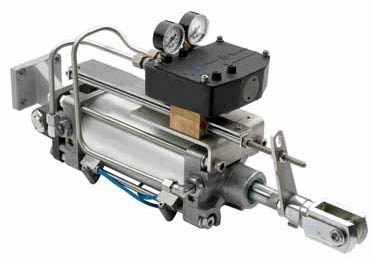The pneumatic base is like hydraulic, but the pneumatic uses gas instead of the liquid. Generally, pneumatic uses compressed air, but nitrogen or other similar gases can be used for specific conditions. With pneumatic, the air inside a receiver is received through a compressor. The receiver stores a large amount of compressed air. The surrounding air contains particles of dust, water vapor and other impurities. Therefore, in pneumatic systems use air filter and air dryer to keep the compressed air clean and dry, which significantly increases the components lifetime and reliability. Pneumatic systems also use a wide range of valves to control the direction, pressure and speed of the operators.
Most pneumatic systems work at a pressure of 100 psi or less. Because of the lower pressures on pneumatic systems, in order to obtain a specific force, more operators are required than hydraulic systems. For example, a hydraulic cylinder with 50mm diameter piston and a pressure of 1000 psi can produce 3140 lbs, while in a pneumatic cylinder, at 100 psi, a cylinder with a minimum diameter of 125mm is required.
Although pneumatic systems operate at lower pressures than hydraulic systems, due to their advantages, they are used in many industries. Since, the hydraulic pressure is lower, the components can be made of lighter and thinner materials, such as aluminum and special plastics, while the hydraulic components are usually made of steel or cast iron. Hydraulic systems are generally rigid, while pneumatic systems usually use cushion or shock absorber. Pneumatic systems are generally easier because the air can be easily drained in the line, while in hydraulic systems, it is possible to drain only through a tank return.
Pneumatic has also advantages over electromechanical transmission methods. Electric motors are usually limited due to the heat generated. Generating heat is not usually problematic in pneumatic motors because the air flow reduces heat generation in the engine. In addition, pneumatic motors do not use heavy, bulky and expensive chassis that are used in electric motors because they do not require power.
Keywords:
Pneumatic system testing, Pneumatic systems repair, repairing and testing of Pneumatic systems, Pneumatic systems, power-pack Pneumatic, Neumatic testing systems, testing Neumatic systems, repairing Neumatic systems, repairing and testing of Neumatic systems, Neumatic systems, Neumatic power-pack.

